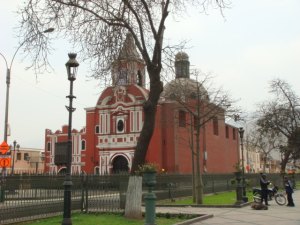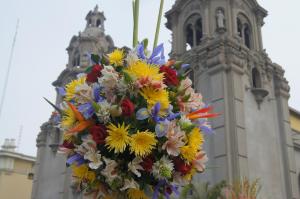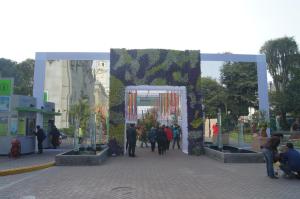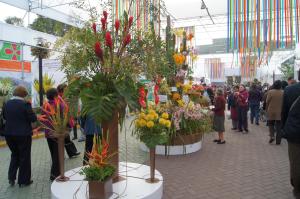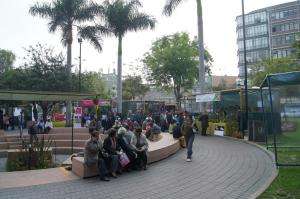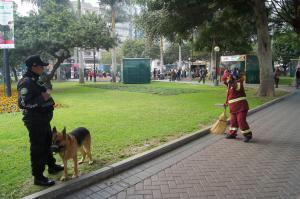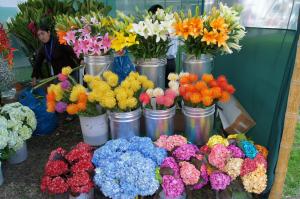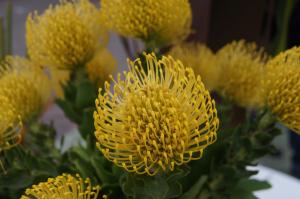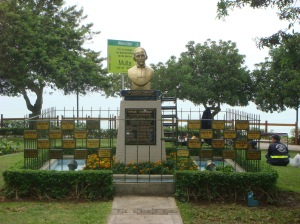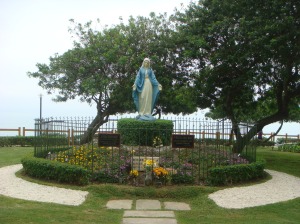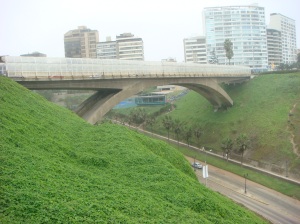Archive for the ‘Art’ Category
- In: Art | History | Lima | Uncategorized
- 1 Comment
 Rímac is one of the oldest districts in Lima and is part of the historical city center. It is located north of the Cercado de Lima, across the River Rímac. The district is accessed by a series of bridges, one of which is the oldest bridge in Lima, the Puente de Pierda, constructed in 1608. The Puente de Pierda joins the Jirón de le Unión pedestrian walkway located in the Cercado de Lima with the Jirón Trujillo, a similar pedestrian walkway in the Rímac district.
Rímac is one of the oldest districts in Lima and is part of the historical city center. It is located north of the Cercado de Lima, across the River Rímac. The district is accessed by a series of bridges, one of which is the oldest bridge in Lima, the Puente de Pierda, constructed in 1608. The Puente de Pierda joins the Jirón de le Unión pedestrian walkway located in the Cercado de Lima with the Jirón Trujillo, a similar pedestrian walkway in the Rímac district.
Today the Rímac district is one of the poorest areas of Lima. It is run down and it can be dangerous. However, due to its long-standing history there are many interesting and important historical sites to see in Rímac.
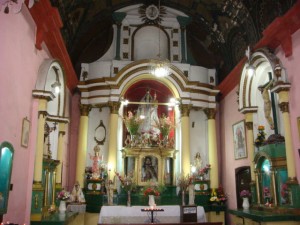 Along the Jíron de Trujillo, you will find the smallest church in Lima called San Jose del Puente. In the 17th century it was an Inn, it later became a chapel and was finally converted into its present status of a church. The church is bright pink on the outside and continues its brightly colored, ornate decor inside.
Along the Jíron de Trujillo, you will find the smallest church in Lima called San Jose del Puente. In the 17th century it was an Inn, it later became a chapel and was finally converted into its present status of a church. The church is bright pink on the outside and continues its brightly colored, ornate decor inside.
 At the end of Jirón you will find the Iglesia de San Lázaro. It was originally constructed as a hospital and leper colony in 1562. Throughout the years the small building was expanded and eventually became a church.
At the end of Jirón you will find the Iglesia de San Lázaro. It was originally constructed as a hospital and leper colony in 1562. Throughout the years the small building was expanded and eventually became a church.
Rímac also used to be the home of the Backus company’s main brewery, which produces Cristal, one of Perú’s top two beers. However, the operation was moved to Ate in 1990.
After winding your way through a number of not so pleasant streets, you will arrive at the Alameda de Los Descalzos (The Boulevard of the Barefooted). The Alameda is well-known for its mention in the song “La Flor de La Canela” by famous Peruvian singer Chabuca Granda. The Alameda de Los Descalzos is a World Heritage Site which has be reconstructed to its original design of 1856.

 As you walk north along the Alameda you have a good view of the Cerro San Cristobal on your right. The walkway is lined by a number of marble statues, many of which, unfortunately, have suffered from time, neglect and vandalism.
As you walk north along the Alameda you have a good view of the Cerro San Cristobal on your right. The walkway is lined by a number of marble statues, many of which, unfortunately, have suffered from time, neglect and vandalism.
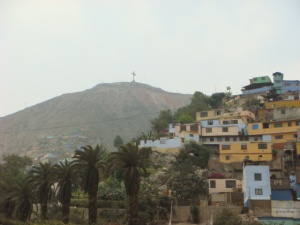
 Two more historic churches flank the Alameda. The Iglesia de Santa Liberata and the Convento Del Patrocinio.
Two more historic churches flank the Alameda. The Iglesia de Santa Liberata and the Convento Del Patrocinio.
At the end of the Alameda de Los Descalzos you end up at the Convent de Los Descalzos, after which the walkway was named. The convent was constructed between 1595-1596 as a retirement home the Franciscan Order of monks. The convent is now a museum which houses some 300 precious paintings of the Lima, Cusco and Quito Schools. Guided tours are offered in Spanish & English and give you the opportunity to see, among other things, the cells of the monks, the dining room, the infirmary, the pharmacy, the bodega, and two old chapels.
 Two other prominent structures in the Rímac district are the Paseo de Aguas and the Plaza de Acho.
Two other prominent structures in the Rímac district are the Paseo de Aguas and the Plaza de Acho.
The Paseo de Aguas was built by the Spanish viceroy Manuel de Amat between 1770 and 1776, in honor of his beloved Perricholi, famous Peruvian entertainer Micaela Villegas. Today the structure actually doesn’t contain any water due to the shortage of water in Lima.
 The Plaza de Torros de Acho is the bull fighting ring in Lima. It is the oldest in the Americas and the second-oldest in the world after La Maestranza in Spain. The structure is composed of wood and adobe and has a seating capacity of 17,000. Bull fighting season is in October and November in Lima during which time some of the world’s best bull fighters come to compete in the annual festival.
The Plaza de Torros de Acho is the bull fighting ring in Lima. It is the oldest in the Americas and the second-oldest in the world after La Maestranza in Spain. The structure is composed of wood and adobe and has a seating capacity of 17,000. Bull fighting season is in October and November in Lima during which time some of the world’s best bull fighters come to compete in the annual festival.
- In: Art | Entertainment | Lima | Nature
- Leave a Comment
It must be a sign that Spring will soon arrive in Lima! There is a flower and plant festival on this week in Parque Kennedy. It is called la Tercera Feria Internacional “Perú Flora 2010: Flores y Plantas”. I went to check it out this afternoon.
The festival is a display of everything to do with flowers and plants. You can buy plants and fresh-cut flowers, there are accessories and tools for gardening, home decor related to flowers and even books on plants and gardening. In addition to the displays from the participating vendors there are a number of other beautiful floral arrangements on display.
On the main concourse in front of the Municipalidad (where we are going to get married) , there is an artistic display made of colorful flower petals.
Further along, in front of La Iglesia de la Virgen Milagrosa, there are a number of interesting floral displays mounted on the lamp posts.
Next, you arrive at the main pavilion which has a mirrored front that provides an interesting reflection of la Municipalidad and la Iglesia.
Inside the pavilion you will find booths of floral displays, flowers and plants for sale, patio furniture and gardening equipment, along with more floral artwork.
The remainder of the participants are located in booths spread throughout the park. Like with most events in Lima there is a strong security presence in the park and as always they are working to ensure that the park is kept clean.
You can find a wide variety of plants and flowers on display including species from the desert, orchids and colorful hydrangeas. Here are some of my favorite images from the feria.
Of course, not everyone is enjoying the flower festival in the park. The cats have been quite disrupted, but they seem to be taking it in stride, especially when they get fed!
Love Park – El Parque Del Amor
Posted on: June 19, 2010
In my post about the Malecón de la Reserva I mentioned that I would write about the Malecón Cisneros and El Parque del Amor.
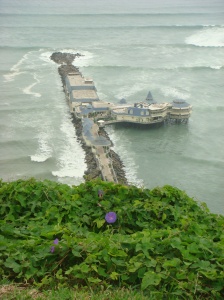 After passing by Larcomar, if you keep heading north you will eventually arrive at El Parque del Amor (Love Park). But before arriving there are some interesting sights along the way. First is the prominent pier, el Espigón 4, where the elegant La Rosa Náutica restaurant is located. Every time I see it I want to go there as it looks so charming. I can just imagine dining there surrounded by the crashing waves and the fresh sea air.
After passing by Larcomar, if you keep heading north you will eventually arrive at El Parque del Amor (Love Park). But before arriving there are some interesting sights along the way. First is the prominent pier, el Espigón 4, where the elegant La Rosa Náutica restaurant is located. Every time I see it I want to go there as it looks so charming. I can just imagine dining there surrounded by the crashing waves and the fresh sea air.
Next you will arrive at El Parque Champagnat, named after the french priest Saint Marcellin Champagnat who founded the Marist Brothers, a religious congregation of men in the Roman Catholic Church dedicated to education. There is a monument of him in the park, along with a statue of the Virgin Mary.
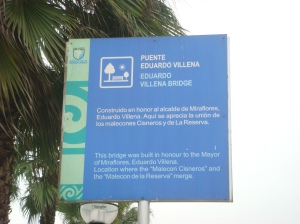 Finally, the Puente Eduardo Villena or Eduado Villena Bridge comes into view. As the sign indicates this is the point at which the Malecón de la Reserva and the Malecón Cisneros meet. It isn’t the most attractive bridge in the world but it serves its purpose of bridging the gap and uniting the two paths.
Finally, the Puente Eduardo Villena or Eduado Villena Bridge comes into view. As the sign indicates this is the point at which the Malecón de la Reserva and the Malecón Cisneros meet. It isn’t the most attractive bridge in the world but it serves its purpose of bridging the gap and uniting the two paths.
On the south side of the bridge you will find another little park called Parque “Gran Mariscal Mariano Necochea”. There is an interesting sculpture in the park which was designed by Fernando de Szyszlo Valdelomar. The sculpture is called Intihuatana, which in quechua (an indigenous language in Peru) means “el lugar en donde el sol se amarra” or “the place where the sun is tied”.
 Once you cross the bridge you enter El Parque del Amor. The park was inaugurated February 14, 1993. The center-piece of the park is a beautiful sculpture dedicated to love called “El Beso” ( The Kiss). It depicts two lovers, supposedly the artist and his wife, engaged in a passionate kiss. It was designed by Peruvian sculptor Victor Delfin. The statue is 12 meters long and 3 meters high. It is said that the locals compete for the longest kiss under the statue.
Once you cross the bridge you enter El Parque del Amor. The park was inaugurated February 14, 1993. The center-piece of the park is a beautiful sculpture dedicated to love called “El Beso” ( The Kiss). It depicts two lovers, supposedly the artist and his wife, engaged in a passionate kiss. It was designed by Peruvian sculptor Victor Delfin. The statue is 12 meters long and 3 meters high. It is said that the locals compete for the longest kiss under the statue.
The park is bordered by an undulating wall of mosaic tiles, where you can read romantic phrases of the best know Peruvian poets.
Located on the cliffs overlooking the Pacific Ocean, the park offers beautiful views of the sunset which attracts lovers looking for a romantic spot. At almost any time of day or night, you can see couples here kissing or snuggled closed together. It is a beautiful, romantic place.
